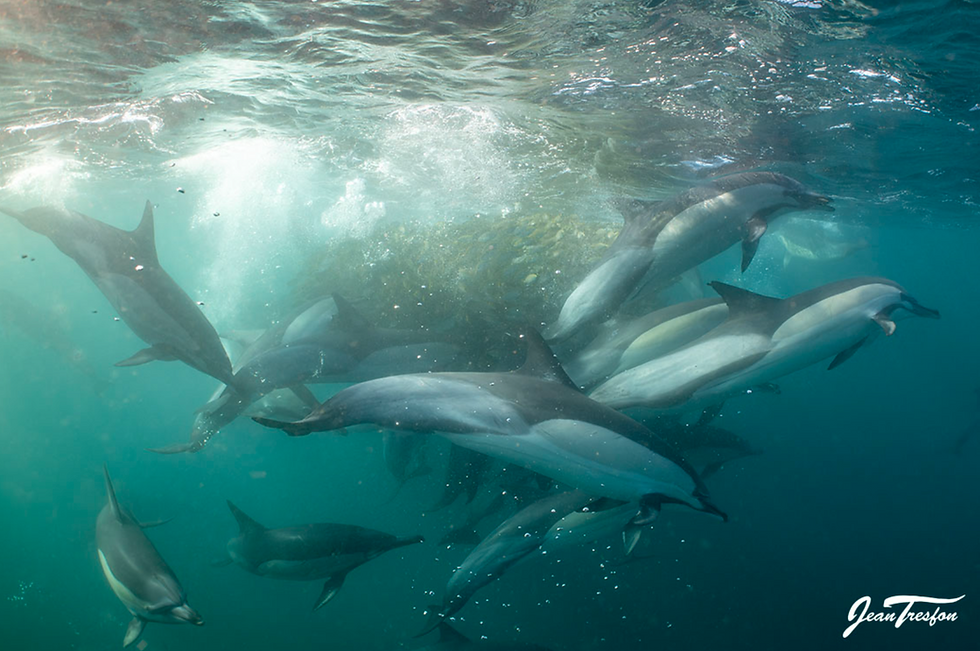Ghost of the Deep: A Rare Encounter with a Kitefin Shark off South Africa.
- Animal Ocean
- Jul 31
- 3 min read
You never really know what you're going to find on the open ocean — especially during the Sardine Run. The water is wild and full of surprises, and sometimes those surprises are more mysterious than magnificent.

While out scanning the seas for sardines off South Africa’s east coast, guides Aiden Biccard and Libby Richardson stumbled upon a strange and haunting sight. A bloated shark was bobbing at the surface, drifting unnaturally in the swell. It looked distressed, its movement slow and uncoordinated — a far cry from the sleek, purposeful grace of a healthy predator. The animal was around a meter long, and immediately, it was clear this was no ordinary coastal species. It looked deep — built for darkness, not daylight.
Suspecting barotrauma — a condition caused by rapid ascent from depth that can leave deep-sea animals unable to control their buoyancy — Aiden and Libby gently attempted to guide it back into deeper water. They swam with it, hoping it might recover its equilibrium. But the effort didn’t seem to help. The shark remained afloat, and eventually, they left it alone, unsure what more could be done.
Back on land, questions turned to identification. The shark’s short snout, strange jawline, and smooth dorsal fins with no visible spines suggested something unusual — something rarely seen alive. And indeed, expert review has since confirmed the suspicion: it was a Kitefin shark, Dalatias licha — a deep-sea species almost never encountered in the shallows. This rare, fleeting moment is now one of the very few known in-water encounters with a live Kitefin shark in the wild.
The Kitefin shark is an elusive creature, a member of the sleeper shark family Dalatiidae, which includes the notorious cookiecutter shark. Both species share an eerie feeding strategy — using large, saw-like lower teeth to gouge circular chunks of flesh from other animals. Cookiecutters have been known to leave neat holes in whales, dolphins, tuna, and even the hulls of submarines. Kitefins take things even further. They’ve been documented feeding on whales, swordfish, and sharks, carving large, crescent-shaped wounds from both living and dead prey. They are both scavengers and predators, thriving in a world of darkness and decay.
Built for the deep, the Kitefin is adapted to life between 200 and 1,800 meters below the surface. Its body is covered in velvety dark grey skin, and its two dorsal fins lack the spines seen in most shark species. The snout is short, the mouth wide, and the eyes large and reflective — tuned to the faintest traces of light. But perhaps the most remarkable feature is one you’d never see without the right camera: this shark glows.
Lined with thousands of photophores along its belly, the Kitefin is bioluminescent — one of the largest glowing vertebrates on Earth. It uses this natural light as camouflage, blending into the faint shimmer of the sea surface above to hide from predators and sneak up on prey. This deep-sea trick, known as counter-illumination, was only recently confirmed by researchers in 2021, who filmed glowing Kitefins in New Zealand using deep-sea submersibles. For decades, the species' ability to produce light was suspected but never seen in action.
Despite being globally distributed in temperate and tropical waters — from the North Atlantic to the Mediterranean, Indian Ocean, and waters off South Africa — Kitefins are almost never seen alive. They’re not fast, and they’re not flashy. They cruise the midwater in silence, feeding on bony fish, squid, crustaceans, and blubber from dead or dying animals. This solitary existence in the shadows, combined with their slow growth, late maturity, and low reproductive rate, makes them acutely vulnerable to human activity. Most are caught not intentionally, but as bycatch in deep-sea trawl and longline fisheries. Their populations are believed to be in slow decline, and the IUCN now lists the species as Vulnerable.
Reproductively, Kitefins are what’s known as aplacental viviparous — meaning they give birth to live young that develop inside the mother, without the use of a placenta. Litters range from 10 to 20 pups, and while the numbers might sound healthy, the slow turnover rate — combined with commercial fishing pressure — makes population recovery extremely difficult.
First described by Bonnaterre in 1788, Dalatias licha has existed in scientific record for centuries, yet so little about it is truly known. Most of what we understand has come from dead specimens hauled up on longlines or trawl nets. To see one alive — even briefly — is a powerful reminder of how little we truly know about what lies beneath the surface.
This encounter off the coast of South Africa, captured through quick thinking and compassionate action, gives us a rare glimpse into that world. A predator from the abyss, floating helplessly in the light. A ghost of the deep, suddenly visible. And a reminder that the ocean still holds stories we’ve barely begun to read.




Comments